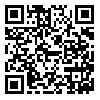Volume 19, Issue 4 (Winter 2025)
Salmand: Iranian Journal of Ageing 2025, 19(4): 630-641 |
Back to browse issues page
Download citation:
BibTeX | RIS | EndNote | Medlars | ProCite | Reference Manager | RefWorks
Send citation to:



BibTeX | RIS | EndNote | Medlars | ProCite | Reference Manager | RefWorks
Send citation to:
Rostamnia D, Marashi T, Sadeghipour Roudsari M, Namdari M. Investigating the Prevalence of Frailty in Community-dwelling Older Adults Living in Tehran City, Iran. Salmand: Iranian Journal of Ageing 2025; 19 (4) :630-641
URL: http://salmandj.uswr.ac.ir/article-1-2632-en.html
URL: http://salmandj.uswr.ac.ir/article-1-2632-en.html
1- School of Public Health and Safety, Shahid Beheshti University of Medical Sciences, Tehran, Iran.
2- Department of Public Health, School of Public Health and Safety, Shahid Beheshti University of Medical Science, Tehran, Iran. ,marashi142002@yahoo.com
3- Department of Public Health, School of Public Health and Safety, Shahid Beheshti University of Medical Science, Tehran, Iran.
2- Department of Public Health, School of Public Health and Safety, Shahid Beheshti University of Medical Science, Tehran, Iran. ,
3- Department of Public Health, School of Public Health and Safety, Shahid Beheshti University of Medical Science, Tehran, Iran.
Abstract: (2447 Views)
Objectives With the increase in human lifespan, frailty has become an increasingly important issue that threatens older adults’ health. In Iran, limited studies have addressed the prevalence of frailty in community-dwelling older adults. Therefore, this study aimed to investigate the prevalence of frailty and its related factors in community-dwelling older adults in Tehran.
Methods & Materials This cross-sectional study was conducted on 383 people aged 60 years and older under the supervision of Shahid Beheshti University of Medical Sciences in Tehran City, Iran, in 2022. We used randomized multi-stage cluster sampling. Data collection was done using the Tilburg frailty indicator (TFI). The researcher asked older adults and completed the questionnaires based on their answers. Statistical analysis was performed using the chi-square test, independent t-test, Fisher exact test, and logistic regression in SPSS software, version 23. The significance level was set at P<0.05.
Results Women constituted 48.80% and men 51.20% of the samples with an average age of 68.20±6.30 years. Among the participants, 72.30% were married. Prevalence of frailty was 40.50%. Frailty was associated with age, being unmarried, lower education level, lower income, unhealthy lifestyle, suffering from several diseases, dissatisfaction with living environment conditions, and some stressful events (P<0.001).
Conclusion This research showed a high prevalence of frailty among community-dwelling older adults living in Tehran. Applying screening programs for frailty in primary care units and early interventions can prevent adverse outcomes.
Methods & Materials This cross-sectional study was conducted on 383 people aged 60 years and older under the supervision of Shahid Beheshti University of Medical Sciences in Tehran City, Iran, in 2022. We used randomized multi-stage cluster sampling. Data collection was done using the Tilburg frailty indicator (TFI). The researcher asked older adults and completed the questionnaires based on their answers. Statistical analysis was performed using the chi-square test, independent t-test, Fisher exact test, and logistic regression in SPSS software, version 23. The significance level was set at P<0.05.
Results Women constituted 48.80% and men 51.20% of the samples with an average age of 68.20±6.30 years. Among the participants, 72.30% were married. Prevalence of frailty was 40.50%. Frailty was associated with age, being unmarried, lower education level, lower income, unhealthy lifestyle, suffering from several diseases, dissatisfaction with living environment conditions, and some stressful events (P<0.001).
Conclusion This research showed a high prevalence of frailty among community-dwelling older adults living in Tehran. Applying screening programs for frailty in primary care units and early interventions can prevent adverse outcomes.
Type of Study: Research |
Subject:
gerontology
Received: 2023/05/25 | Accepted: 2024/02/07 | Published: 2025/01/01
Received: 2023/05/25 | Accepted: 2024/02/07 | Published: 2025/01/01
Send email to the article author
| Rights and permissions | |
 |
This work is licensed under a Creative Commons Attribution-NonCommercial 4.0 International License. |








